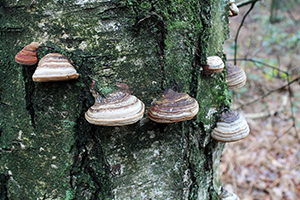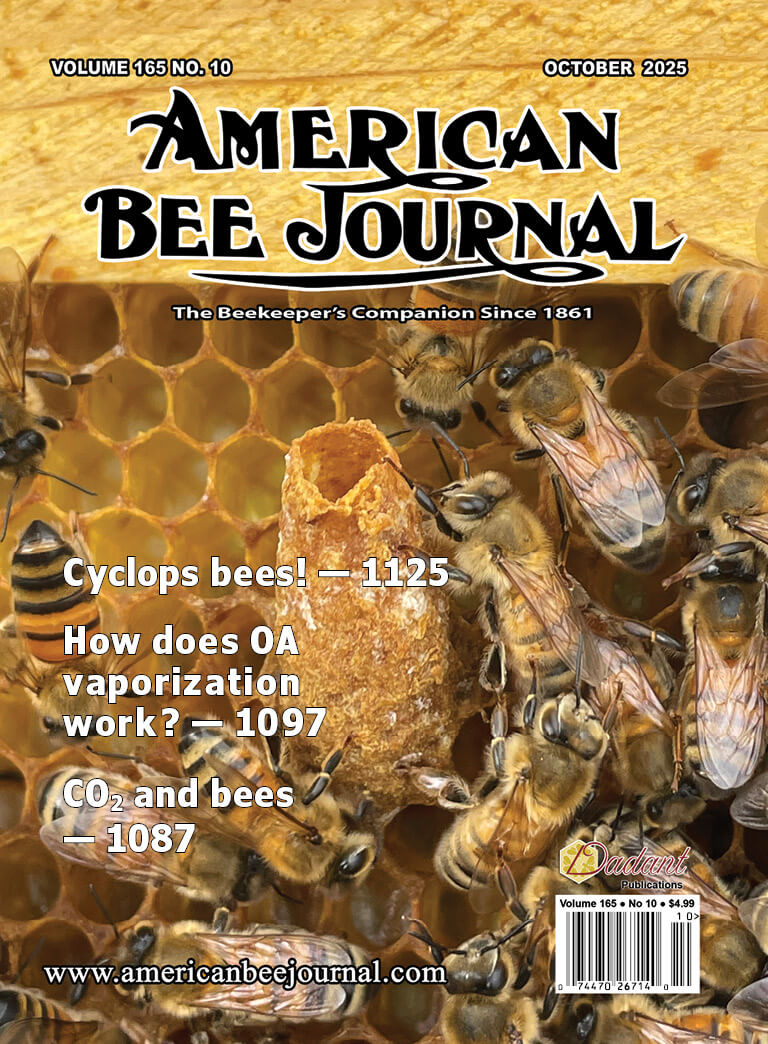
Mushroom extracts might help honey bees fight off viruses, but many questions remain
I can’t go for a walk in the woods without stopping to examine, poke, and sniff every mushroom I stumble upon. Every fall, I harvest as many chanterelles, hedgehogs, shaggy manes, cauliflowers, and delicious milky caps as I can reasonably process and store for the rest of the year. Clearly, my curiosity over mushrooms is driven by an obsession with the edibles (not the drugs), but mushrooms have more to offer than just a freshly foraged meal.
Mushrooms are nature’s chemists, synthesizing useful molecules that aren’t found anywhere else on Earth. They are masterful chemical engineers. Slowly, silently, they deconstruct rocks and digest logs into soil with chemicals exuded from their mycelia (root-like filaments). Mushrooms are constantly competing with microbes for food and space, and this competition has fueled the fungi to develop invaluable antimicrobial compounds — some of which even have activity against viruses like HIV, polio, influenza, and now, two prevalent honey bee viruses. can’t go for a walk in the woods without stopping to examine, poke, and sniff every mushroom I stumble upon. Every fall, I harvest as many chanterelles, hedgehogs, shaggy manes, cauliflowers, and delicious milky caps as I can reasonably process and store for the rest of the year. Clearly, my curiosity over mushrooms is driven by an obsession with the edibles (not the drugs), but mushrooms have more to offer than just a freshly foraged meal. can’t go for a walk in the woods without stopping to examine, poke, and sniff every mushroom I stumble upon. Every fall, I harvest as many chanterelles, hedgehogs, shaggy manes, cauliflowers, and delicious milky caps as I can reasonably process and store for the rest of the year. Clearly, my curiosity over mushrooms is driven by an obsession with the edibles (not the drugs), but mushrooms have more to offer than just a freshly foraged meal.
Last year, Paul Stamets (mushroom guru and founder of Fungi Perfecti) teamed up with Dr. Steve Sheppard to investigate antiviral activity in mushroom extracts.1 I heard Stamets talk about this research at the BC Honey Producers’ Annual General Meeting in Vancouver, Canada, back in 2016 and had been awaiting this publication ever since. As they describe in their Scientific Reports article, Stamets, Sheppard and their colleagues fed honey bee colonies crude mushroom extract diluted in sugar syrup and observed a marked decrease in two viruses, DWV (deformed wing virus) and LSV (Lake Sinai virus) in less than two weeks.
This work has received a lot of hype, and understandably so. The intriguing world of mushrooms is enough to make many of us lean in to a tale, and adding honey bees to the mix makes for a slam dunk news story. But how much do we really know, and where is the research at now?
Stamets is a visionary and an ambitious inventor — over the years, he has acquired at least five patents for different fungal products. His first patent2 was for a method of using infectious fungi to control carpenter ant, fire ant, and termite populations by tricking the insects to eat the fungal spores, which then sporulate and take over the unsuspecting insect’s body (much like a chalkbrood mummy). The trick is, the ants and termites are attracted to the non-sporulating stage and repelled from the mummies. So not only do the present occupants die, once a nest has succumbed to the fungus, new scouts avoid that area like the plague.
His next patent3 — which was filed eleven years ago — took this idea a step further, proposing that similar fungal baits could be used as potential biocontrol agents, or biopesticides, for agricultural operations to deploy. One of the target species listed on the patent is actually our beloved honey bee (presumably motivated by the public fear of killer bees). Clearly much has changed since then: Now, Stamets is actually trying to help out the honey bees by developing that same technology to try to control Varroa destructor. And that is not the only way he is trying to lend honey bees a hand.
At his talk in Vancouver, Stamets described how he once noticed honey bees foraging on a bed of wood chips. Inspecting the commotion more closely, he saw that they were actually harvesting droplets oozing out from some fungi growing in the same bed. It was as close to an “Aha!” moment as anyone could hope for. Maybe the bees were self-medicating with the mushroom’s pharmacy!
Stamets and Sheppard wanted to test this idea that mushrooms could contain microbe-fighting agents that are beneficial for honey bees. They focused on amadou (Fomes fomentarius) and reishi (Ganoderma resinaceum) mushrooms, which are types of bracket fungi. This is the kind that you see growing on trees in the shape of a semicircle, like shelves. The tough bracket is not the part of the fungus that Stamets and Sheppard used, though. Instead, they cultured the mycelium — the white, filamentous root-like web of the fungi — on birch wood chips and extracted materials from that, wood chips and all. In their paper, they describe macerating this material in a mixture of ethanol and water, then filtering it to make what sounds like a boozy mushroom iced tea. In a short field trial, Stamets and Sheppard fed colonies either sugar syrup alone or syrup spiked with 1% amadou or reishi extract. All the extract-treated colonies showed a decrease in DWV and LSV levels during the experiment, although it is unclear how much of this is due to compounds in the birch chip substrate, the mushrooms in question, or other contaminating fungi they identified. In preliminary cage trials, the researchers investigated whether the extract from unsterilized wood chips alone might contain active compounds, and it did appear to have activity comparable to the amadou extract against LSV infection. But the birch chip extract wasn’t tested in the field.
“The results look very promising and worth investigating further,” says Dr. Renata Borba, a researcher at Beaverlodge, Canada, who specialized in the benefits of plant resins to honey bee health and wasn’t involved in the study. But she cautions that it “leaves the reader with lots of questions.” In particular, we still don’t know the active ingredient in the fungal extract, we don’t know how long the antiviral effect lasts, and we don’t know how safe it is for honey bees. Does the extract interfere with the honey bee gut microbial community? Does the extract interfere with the bees’ innate immune system? “Both the cage and field experiments were very short,” Borba says. “It will be interesting to investigate the longevity of this anti-viral effect and other ‘side-effects’ that it may cause.”
There is much more work to be done before a treatment like this can become mainstream. In 2017, a short research update was posted on the Fungi Perfecti website describing how….


